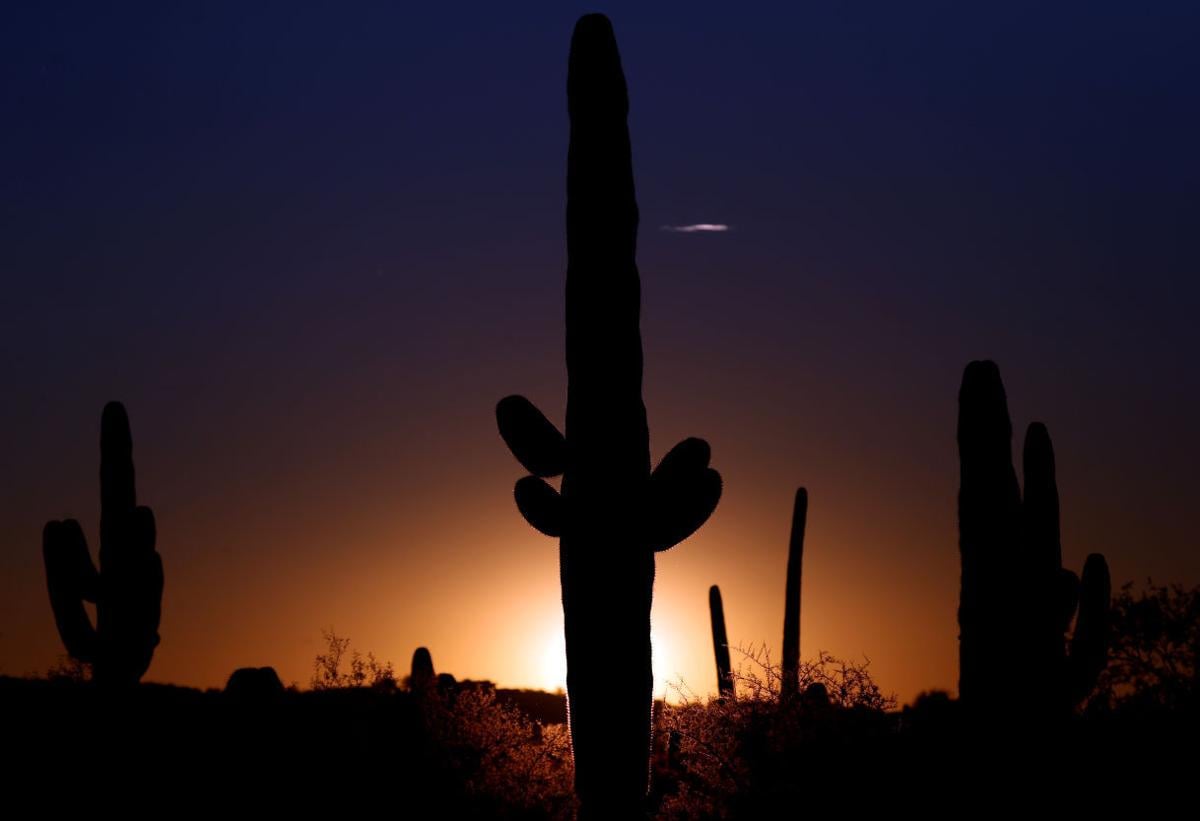The saguaro is a freak of nature.
Really, it’s a freak and that’s why we love it so.
The towering Carnegiea gigantea has always cast an improbable shadow on the landscape of the Sonoran Desert. With an adult height of 40 feet and a taproot less than two feet deep, it’s a wonder it stands and survives, let alone thrives in the upland desert surrounding Tucson.
Now we’re finding out it also has peculiar genes. “It is absolutely unusual,” said Mike Sanderson, professor of ecology and evolutionary biology at the University of Arizona.
When Sanderson and crew assembled the genome of Arizona’s iconic cactus recently, they found that the genes responsible for saguaro photosynthesis are pretty much missing.
Sanderson led a large collaboration that sequenced the 1.5 billion base pairs of saguaro’s genome. It’s a big one — bigger than rice and about half the size of the human genome.
The team, primarily a collaboration between the UA and its sister institution in Sonora, the Autonomous University of Mexico or UNAM, also includes researchers from Arizona State University and the University of Michigan.
The team is still analyzing and reconstructing the main part of the genome, but has completed the map of its plastid or chloroplast genome — the portion responsible for photosynthesis.
The plastid genome is the smallest genome on record for a flowering plant that uses photosynthesis, said Sanderson. Saguaro has, somehow, found a different pathway for creating sugars from sunlight.
Sanderson is a “tree of life” guy, most interested in assembling the ecological history of species. The saguaro genome will help him discover the origin of this particular species — when and where it branched off on the phylogenetic tree from some ancient ancestor of saguaro and related giant woody cacti such as cardon, senita and organ pipe.
He has seen some clues in the analyses done so far that indicate big differences in the genome of saguaros sampled south of Guaymas, Sonora, but he cautions that the observation is very preliminary. “I actually just noticed it last weekend,” he said in a Monday interview.
Once completed, the genomic analysis of saguaro will be openly available to researchers and will provide rich opportunities for exploring the plant’s biology, he said.
The saguaro is already “the most studied plant in the Sonoran Desert,” according to “A Natural History of the Sonoran Desert,” the bible of our region, put together by the Arizona-Sonora Desert Museum and now available in a second edition.
Don Swann, biologist at Saguaro National Park, said this recent academic exploration of his park’s signature plant continues a long collaboration between park rangers and the University of Arizona.
The east, or Rincon Mountain unit of the park, was established as a national monument in 1933, in large part because of the urging of UA President Homer Shantz, a biologist who recognized the need to protect the saguaro-studded flanks of the Rincon Mountains.
Research on the saguaro has continued over the past 83 years, with important contributions from the scientists at the Desert Laboratory at Tumamoc Hill (now owned by the UA) and the Arizona-Sonora Desert Museum, neighbor to the park’s west addition, which became part of the national monument in 1961.
Continual research and monitoring is necessary for a plant as long-lived as the saguaro, said Swann. He noted that retired UA researchers Tom Orum and Nancy Ferguson, who are still monitoring saguaro plots 37 years after taking charge of them, represent the “third-generation” of researchers on that project.
That continuous monitoring is important in understanding what’s going on with the saguaro population, he said.
Saguaros are prodigious seed producers, putting out an estimated 40 million seeds over a lifetime, but most seeds are eaten and the few saguaros that do germinate seldom survive their slow-growing youth. It takes about 40 years for a saguaro to grow 3 feet high and “resistant to weather extremes and animal damage,” according to the “Natural History of the Sonoran Desert.”
At times, the saguaro population appears to be in sharp decline, said Swann, as was the case shortly after the monument was created in 1933. The big stands of giants that drew President Shantz to photograph the region were dying and the incoming young saguaros weren’t visible in photographs.
Populations came back in the wet years of the mid-1960s into the 1990s and scientists began to realize that it took years of optimum conditions to produce the next big wave of saguaros.
“You really need kind of the perfect climatic conditions to get that wave of saguaros,” he said.
“It really takes generations of science and scientists to fully understand what’s going on with plants that live longer than we do,” Swann said.
Swann and Sanderson will be speaking Tuesday at the University of Arizona about current and past scientific collaborations between the Forest Service and the university. Also speaking is Michael Rosenzweig, director of Tumamoc Hill.
Saguaro National Park will also honor Ray Turner, a U.S. Geological Survey researcher and geosciences professor at UA, for his lifetime of scientific contributions to the study of the region’s famous cactus.





